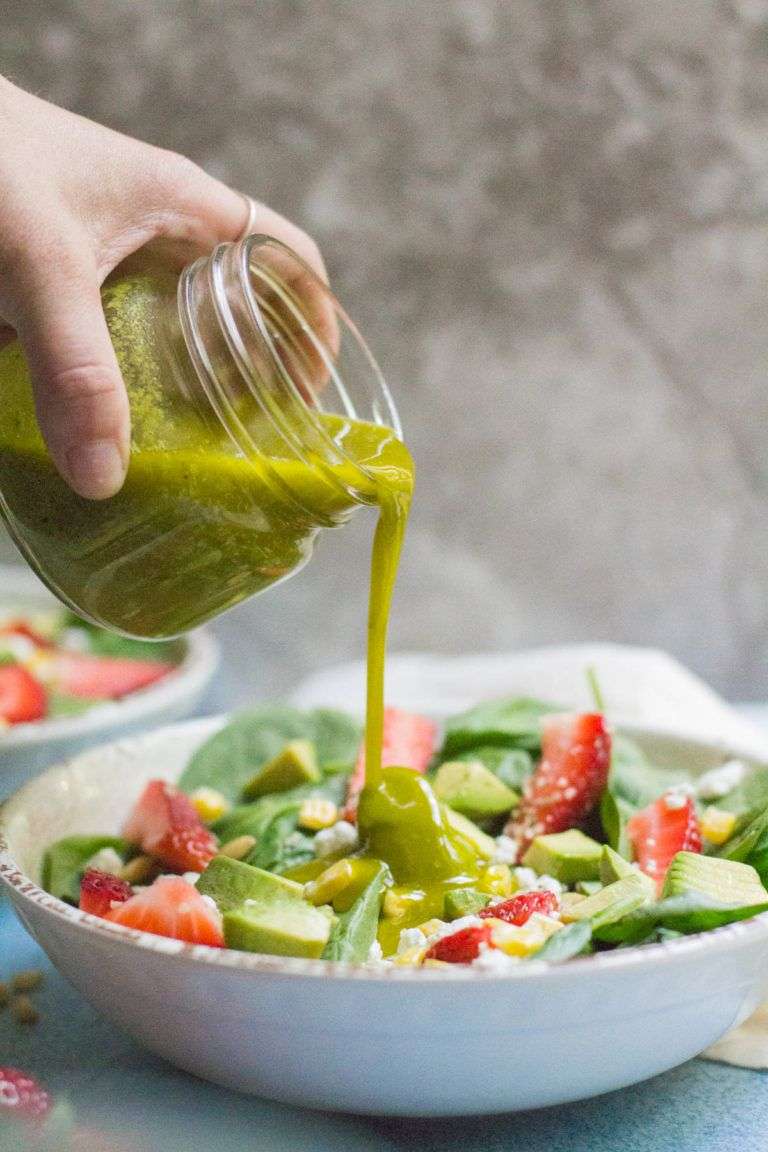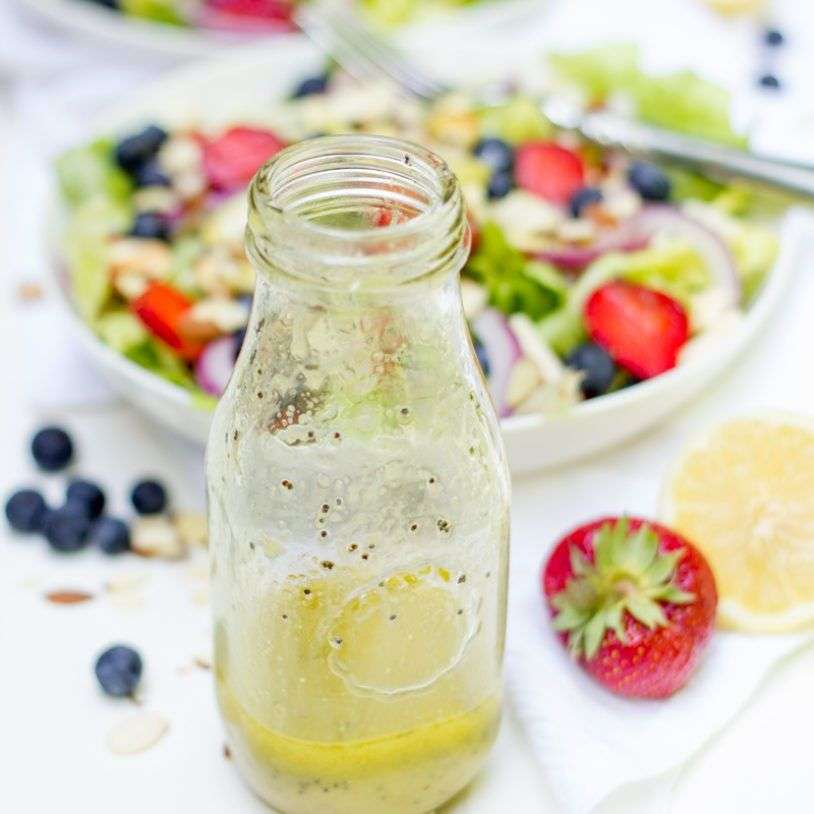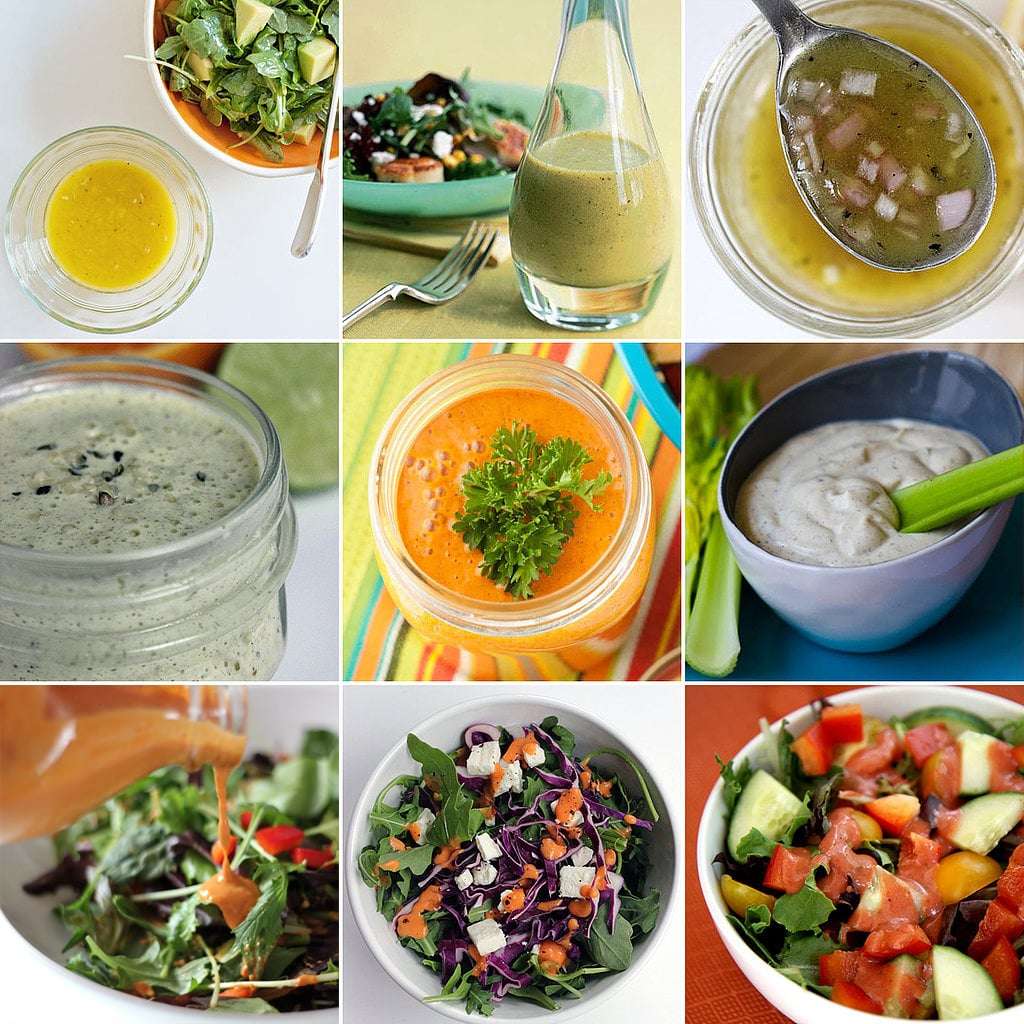How To Store Homemade Dressings
Storing: Most homemade dressings will last in the refrigerator for 5-7 days in an airtight container. I like to store them in glass mason jars.
Freezing: We dont recommend freezing homemade dressings. Theyre best if eaten fresh!
Dressings will separate as they sit in the fridge. If your dressing separates you can whisk it together, shake vigorously or blend again to reconstitute the dressing.
Solidifying: Your dressing might get a bit solidified in the refrigerator dont worry! Simply set it on the counter for 20 minutes or pop in the microwave for 5-10 seconds and stir.
All Oils Aren’t Created Equal
The study was small, with just 29 people.
But the findings suggest that when it comes to the absorption of fat-soluble carotenoids, all dietary oils are not created equal, says researcher Mario Ferruzzi, PhD, who is an associate professor of food science at Purdue University in West Lafayette, Ind.
In earlier research, Ferruzzi and colleagues found that people who ate salads topped with fat-free dressing took in almost none of the available carotenoids, suggesting that dietary fat is necessary to absorb fat-soluble nutrients.
In the new study, the researchers examined whether the amount and type of fat plays a role in nutrient intake.
To do this, study participants ate salads dressed with either 3 grams, 8 grams, or 20 grams of canola oil, soybean oil, or butter.
The typical commercial full-fat salad dressing has 10 to 20 grams of fat per serving, while low-fat versions have about 3 grams.
Nutrient intake was measured in the study subjects through blood samples.
Surprisingly, salads made with polyunsaturated soybean oil were the most dose dependent. The more soybean oil the subjects consumed the more carotenoids they absorbed.
Saturated fat dressings were also dose dependent, but to a lesser extent.
Monounsaturated canola oil dressings, on the other hand, promoted the same level of carotenoid absorption with a 3 gram serving as a 20 gram serving.
The Top 5 Healthiest Salad Dressings Youll Find On Australian Supermarket Shelves
Don’t let your dressing be the downfall of your otherwise healthy salad.
Which salad dressings are the healthiest? Image: Unsplash
While salads are always thought to be the healthiest options if youre trying to lose weight, what dressing you choose can hide a surprising amount of calories. Dietitian Melissa Meier helps you dodge common salad dressing mistakes.
Salads are synonymous with healthy eating, but contrary to popular belief, theyre not always the most nutritious thing on the menu. Of course, anything with vegetables is a step in the right direction but if a salad is packed with high-GI carbs and processed meats, and is drenched in mayonnaise, its probably not doing your health many favours.
Recommended Reading: How To Make A Good Pasta Salad
Types Of Salad Dressing
There are a lot of different homemade salad dressing recipes, so youre sure to find a new favorite. Salad dressings can vary in texture, as some are thick and creamy, while others are very thin and light. These two types of dressings are called vinaigrettes and creamy dressings.
Vinaigrettes are typically made with oil, vinegar, spices, sugars, herbs, and other ingredients. At the same time, creamy dressings are usually based on mayonnaise or other fermented milk products such as sour cream, yogurt, or buttermilk.
Makoto Original Ginger Dressing

If you love the salad dressing at Japanese restaurants, now you can enjoy it at home, too. With only 80 calories and 1g sugar per 2 tablespoons, it can be a staple in your salads, grain bowls and marinades, says Harris-Pincus. Look for it in the refrigerated produce section at the supermarket.
If you’re more of a DIY gal, here are healthy sauce ideas from chef Sophia Roe. And if you’re looking for ideas to take your TJ’s cauliflower gnocchi to the next level, enjoy these easy sauces.
Don’t Miss: Cpk Super Spinach And Quinoa Salad
My Favorite Healthy Store
1. Whole Foods Garlic Tahini Dressing If I had to pick a favorite dressing this would probably be it. Tahini is the best and I love it combined with lemon and garlic for a zesty light dressing thats oil-free, low in calories and sugar, but still tastes rich. This is the dressing that Whole Foods uses for their garlicky kale salad. Dont have a Whole Foods nearby or what to make it yourself? I have a copy-cat garlic tahini dressing recipe here.
- Ingredients: Filtered Water, Roasted Garlic Puree , Sesame Tahini , Apple Cider Vinegar, Soy Sauce , Vinegar, Lactic Acid), Dried Yeast, Lemon Juice Concentrate, Non-GMO Corn Starch, Xanthan Gum.
- Nutrition: 2 Tablespoons = 45 cals, 2.5g fat, 96mg sodium, 4g carbs, 1g fiber, 0g sugar, 2g protein
2. Primal Kitchen Honey Mustard Being a honey mustard fan my whole life its no surprise that this dressing from Primal Kitchen caught my eye immediately. After one taste I was hooked. I love the sweet and savory combo its got going on. I love that Primal Kitchen dressings are made with avocado oil, which is loaded with antioxidants and omega-3 fatty acids.
- Ingredients: Avocado Oil, Water, Organic Apple Cider Vinegar, Organic Stone Ground Mustard , Organic Honey, Organic Lemon Juice Concentrate, Sea Salt
- Nutrition facts: 2 Tablespoons = 110 cals, 11g fat, 180mg sodium, 3g carbs, 0g fiber, 2g sugar, 0g protein
How To Choose The Healthiest Salad Dressing
Study Touts Benefits of Salad Dressings Made With Monounsaturated Oils
When researchers at Purdue University fed study participants vegetable salads topped with different types of oil, they found that dressings containing canola oil best promoted the absorption of fat-soluble carotenoids.
Carotenoids such as lutein, lycopene, beta-carotene, and zeaxanthin are widely believed to promote good health. Specifically, studies suggest that they lower the risk for certain cancers, heart disease, and the age-related eye condition macular degeneration.
In the study, published online in the journal Molecular Nutrition & Food Research, salads dressed with canola oil, which is a monounsaturated fat, required the least fat intake to get a substantial level of carotenoid absorption.
People who ate dressings made with polyunsaturated soybean oil and butter, which is a saturated fat, had to eat far more fat to get the same nutritional benefit.
Also Check: Apple Cider Vinegar Salad Dressing
How To Store Healthy Salad Dressings
While each salad dressing may differ slightly with its storage recommendations, most often storing them in a mason jar with a lid is your best option! If you happen to have a glass salad dressing jar, that is great too.
If it is an oil based dressing the oil may solidify and separate during refrigeration. That is normal! Just bring it to room temperature and shake your jar to combine it again.
The Easiest Healthy Salad Dressing
My last salad dressing is the salad dressing you can make when you really don’t have much time! This is what I do when I’m making a fast lunch just for myself and don’t have any other dressings on hand. It’s basically the perfect combination of lemon, olive oil, and vinegar over fresh greens.
to see my demonstration video to make it.
Don’t Miss: Wendy’s Apple Pecan Chicken Salad Nutrition
Morrisons Counted Soy Chilli And Ginger Dressing
Rating for calorie-counters: 10/10
Cal:51 kCal – lowest calorie count!
Fat: 0.3g
Sat fat: 0.1g – lowest sat fat!
Sugar: 9.5g
Salt:1.43g
Price: 85p for 250ml from Morrisons
Verdict: This dressing tops the list for us in terms of healthiest salad dressing, with the lowest calorie count. And it’s no surprise, as it was created by Morrisons with the WeightWatchers SmartPoints system in mind, so is just about fat free and calorie controlled, making it a great option for those watching their weight. That’s shown in the low calorie count too – the lowest of our entire selection!
Tessemaes Organic Zesty Ranch
This vegan ranch dressing is life changing. Tessemaes organic zesty ranch is made with organic ingredients including heart-healthy olive oil, garlic, mustard, lemon juice, and other herbs and spices for a flavorful and tangy combination.
This healthy dressing is also free from dairy, sugar, gluten, and its non-GMO and Whole 30 compliant. Massage this dressing into chopped kale, mix in with quinoa, chickpeas, and herbs for a fresh lunch, or liberally drizzle over your salad bowl yum.
Read Also: Chicken Salad Chick Madame Curry
Healthy Salad Dressing Brands To Buy
Whether your incentive is to lose weight fast or improve your overall health, tossing your own homemade salad with a healthy salad dressing is a great way to get your greens in. But if you’re opting for store-bought salad dressings, the sauce may be the reason you’re not witnessing your waistline whittle down. Why? The bottled brand you buy will play a role in how many calories you consume.
In fact, many bottled salad toppers are jam-packed with bloating amounts of salt and sugar in addition to sketchy dyes and preservatives. So why taint your nutritious bowl with these health-undoing ingredients? If you’re bored of plain ol’ olive oil and lemon juice or don’t have the time or ingredients to whip up a flavorful salad dressing at home, we’ve put together a guide that’ll help you sort through the good and bad bottles at the supermarket.
You May Not Have Tried Some Of These Simple Nutrient

Cynthia Sass is a nutritionist and registered dietitian with master’s degrees in both nutrition science and public health. Frequently seen on national TV, she’s Health’s contributing nutrition editor and counsels clients one-on-one through her virtual private practice. Cynthia is board certified as a specialist in sports dietetics and has consulted for five professional sports teams, including five seasons with the New York Yankees. She is currently the nutrition consultant for UCLA’s Executive Health program. Sass is also a three-time New York Times best-selling author and Certified Plant Based Professional Cook. Connect with her on Instagram and Facebook, or visit www.CynthiaSass.com.
- Pin
We independently research, test, review, and recommend the bestproductslearn more about our process. If you buy something through our links, we may earn a commission.
I’m a salad fanatic. I’ve eaten one nearly every day for years, and I love experimenting with different combinations of greens, toppings, and dressings. The latter is key, because the right dressing can significantly boost the healthfulness of your bowl, while the wrong one can add all kinds of surplus calories, sugar, unhealthy fat, and artificial ingredients. Here are my recommendations for the best ways to dress your salad, including a few less conventional options you may not have tried yet.
Recommended Reading: Joseph Joseph Salad Bowl With Servers
Where To Buy Healthy Salad Dressings
In terms of purchasing, all of these dressings can be purchased at Whole Foods. You can likely find the Braggs, Primal Kitchen and Tessemaes dressings at other natural grocery stores and some mainstream grocers just look on the natural food aisle. I usually buy my Primal Kitchen products from Thrive Market. If you havent tried Thrive Market yet, its like Costco, but for natural products and its all online.
Healthy Greek Yogurt Ranch Dressing
This twist on classic Ranch dressing tastes so good you’ll never realize it’s good for you! Instead of being made with mayo, the base is greek yogurt making it a rich and creamy dressing without the calories. It’s even filled with probiotics from the yogurt.
The Healthy Homemade Greek Yogurt Ranch Dressing can be used as a dressing or a dip and is great on any salad you’d normally serve with ranch. Try it with my Vegetarian Cobb Salad. It’s also great as a dip for my Baked Zucchini Fries.
Read Also: Easy Corn And Tomato Salad
The Healthiest Salad Dressings Ranked By Nutritionists
Salads can be a great source of healthy fats, fiber, protein and other nutrients, but things can quickly go downhill with additions like fried foods croutons and bacon, were looking at you and the all-important dressing. While drenching your kale salad with ranch might make it more delicious, youre simultaneously dialing down its health benefits.
Store-bought dressings are often high in saturated fat, sodium, added sugar and calories, in addition to artificial colors, flavors and preservatives. And it all adds up while a typical serving size is 2 tablespoons, its not uncommon for people to use more.
Getting familiar with serving sizes and having measuring spoons and cups at home is a good way to practice so that eventually you can eyeball correct portions in order to keep them in check, Rebecca Ditkoff, a registered dietitian and founder of Nutrition by RD, told HuffPost.
We chatted with three nutritionists to gain some insight into what makes a salad dressing healthy or unhealthy, and asked them to rank some of the nations most popular varieties.
The #1 Best Salad Dressing To Eat According To A Dietitian
Salads are one of the healthiest lunch ideas, right? Well, mostly right. While salads are a great source of antioxidant-rich veggies, essential micronutrients, and fiber, they can also be made to be nearly as unhealthy as a fast-food burger depending on which salad dressing you choose to drizzle on top. In fact, some of the worst restaurant salads can contain upwards of 2,000 calories and 30 grams of saturated fatthat’s over 150% of your daily value! But don’t be dissuaded into skipping your lunchtime salad just because of these few bad apples. Just make sure you know the right salad dressings to use.
Lauren Manaker, MS, RDN, of Nutrition Now Counseling and member of the Eat This, Not That! Medical Expert Board, tells us that she’s a big proponent of any kind of food or meal that helps people add more veggies to their diets. “And using salad dressings can make eating these nutrient-packed foods exciting and enjoyable,” she says.
“Unfortunately, some salad dressings can be loaded with sodium, added sugars , and artificial colors and flavors,” says Manaker.
So what salad dressing should you be using? Manaker says that the best salad dressing is one that you make yourself.
Recommended Reading: How Many Calories In An Egg Salad Sandwich
Why Make Your Own Salad Dressing
If youve taken the time to make a big healthy salad chock full of fresh veggies, you dont want to ruin it with a salad dressing with questionable ingredients. Making your own is the best way to ensure your salad dressing is fresh and nutritious.
Here are just a few of the reasons you should set aside a few minutes to make your own salad dressing:
- Store bought salad dressings usually have a lot of refined sugar.
- To make salad dressing shelf-stable, manufacturers have to use chemical preservatives.
- Salad dressing can be high in bad fats and calories.
- When you make your own salad dressing, you know it was made with fresh ingredients.
- These homemade dressings taste way better!
- Its cheaper to make your own.
- You can make salad dressing to fit any eating plan gluten-free, paleo, keto, Whole30 and more!
Make These Healthy Homemade Salad Dressings At Home
I hope you’ll give some of these Healthy Homemade Salad Dressings a try at home. They are all so tasty and unique. With this variety, you’ll never have to buy the bottle again.
If you make these recipes, Id love to hear what you think! Leave a comment and a star rating below. Make sure to follow me on , , and too!
Recommended Reading: Bumble Bee Buffalo Chicken Salad
Caesar: Annies Organic Caesar Dressing
Caesar dressing was meant to be decadent but that doesnt mean it has to be overly processed or complicated. Annies crafted a full-fat dressing that gets its healthy fats from olive oil, not milk fat and doesnt skimp on flavor. While there were some Greek yogurt-based versions of Caesar dressing in the running, Annies won out because its only 110 calories per serving, and sometimes, full-fat dressing is just healthier.
Creamy & Healthy Thai Peanut Dressing

Do you love that peanut sauce at Thai restaurants? This salad dressing tastes JUST like that but in a salad dressing form. My Creamy and Healthy Thai Peanut Dressing is so good you’ll want to drink it out of the bottle! It’s great on any Asian inspired salad, as a dip, and even as a pasta sauce.
Serve it with my Thai Peanut Noodle Salad.
Serve it with my Shrimp Avocado and Lime Salad.
Don’t Miss: Where Can I Get A Good Salad Around Me
How To Spot A Healthy Salad Dressing
Read Those Labels Typically the shorter the ingredient list, the better. Look for clean ingredient lists without cheap, hydrogenated oils, HFCS, tons of additives, food coloring and thickeners. Once youve looked at the ingredient list, check out the nutrition facts so you know exactly how much is a serving, usually 2 Tablespoons but sometimes it will differ depending on brand). For instance, I know Tessemaes dressings are 1 Tablespoon per serving instead of 2. Look at the sugar content and be mindful about how many calories are in a serving.
Skip Fat-Free Dressings Healthy fats are good for us and research shows pairing a salad with a little fat can help our bodies absorb all the nutrients in those veggies. Whenever a packaged item says fat-free it usually means that the item is loaded with extra sugar to make up for the lost favor from fat. No bueno!
Skip the Vegetable Oils Most vegetable oils are highly processed, usually made from GMO crops and rich in omega-6 fatty acids, which can contribute to inflammation when consumed in access. While both omega-3 and omega-6 are essential fatty acids the ideal omega-6:omega-3 ratio is 4:1, but with the Standard America Diet our ratio is much higher . Studies show that diets high in omega-6 fatty acids are pro-inflammatory while diets high in omega-3 fatty acids are anti-inflammatory. See my post on cooking oils for more info on this.